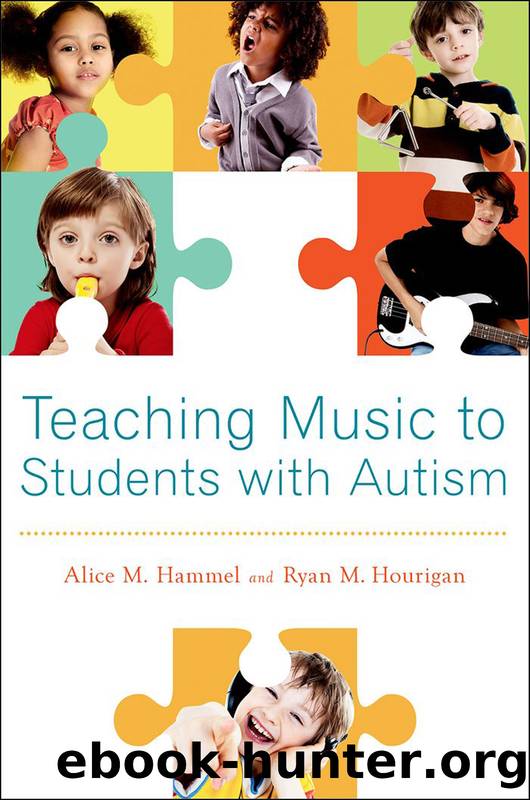Teaching Music to Students with Autism by Hammel Alice M.;Hourigan Ryan M.;

Author:Hammel, Alice M.;Hourigan, Ryan M.;
Language: eng
Format: epub
Publisher: Oxford University Press, Incorporated
Published: 2013-08-15T00:00:00+00:00
Figure 5.4
Band. PECS schedule constructed on Boardmaker
Suggested use: Put title, symbol representing the activity, individualâs name, or individualâs picture in the first cell. Laminate sheet and attach cells above with Velcro. As each task is completed, remove the corresponding symbol and place it in the envelope. Use Boardmaker to place Picture Communication Symbols here.
Source: The Picture Communications Symbols ©1981â2011 by Mayer-Johnson LLC. All Rights Reserved Worldwide. Used with permission. Boardmaker® is a trademark of Mayer-Johnston LLC.
Students with autism may carry a notebook with pre-made icons in place. These icons can be arranged to represent the order of the activities in a music lesson or ensemble rehearsal. This particular schedule shown in figure 5.3 is for a general music classroom and a band rehearsal. A student places icons on the schedule according to the music class schedule. Velcro is used to attach the pictures. After the event is over, the student places the icons in the envelope, signifying that the event is finished and the next event is ready to begin. A student may also carry dividers for each class. A paraprofessional can arrange icons according to the schedule provided by each teacher. This assists students with autism in predicting their day and decreases anxiety regarding the expectations and activities of each portion of the day. Figure 5.4 is an example for an older student attending a band class.
A disruption in a schedule can make a student with autism uncomfortable and anxious. Teachers can reduce these occurrences (e.g., meltdowns) by priming the student for the changes in the schedule far in advance. This may include showing her pictures of the event, creating social stories about what will happen at the event (see chapter 3), and using other reinforcers to assist with communication. As an example, if a music teacher is having a concert in the auditorium, he may need to prepare a student with autism by taking him to the auditorium ahead of time. The teacher may take a picture of the audience to show the student, and have a microphone set up so the student will know the potential volume. In addition, the teacher may allow the student to attend similar concerts in the auditorium so he can experience what it is like during a performance. Obviously, this should be done in consultation with the special education team and perhaps the parents. There are many extra steps that can be taken to make a concert run smoothly for a student with autism. This preparation creates a more positive and meaningful experience for all students (and parents). These techniques may also have assisted Timmy in preparation for the dance party (as would have a pair of headphones to dampen the sound and sunglasses for the visual stimuli).
Behaviors connected to changes in schedules can also be about loss of control. Students with autism often feel most comfortable when life is predictable and controllable. Music teachers may transition into these changes by allowing the student to control the classroom schedule. For example, if
Download
This site does not store any files on its server. We only index and link to content provided by other sites. Please contact the content providers to delete copyright contents if any and email us, we'll remove relevant links or contents immediately.
The Art of Thinking Clearly by Rolf Dobelli(9910)
The 5 Love Languages: The Secret to Love That Lasts by Gary Chapman(9278)
Mindhunter: Inside the FBI's Elite Serial Crime Unit by John E. Douglas & Mark Olshaker(8699)
Becoming Supernatural by Dr. Joe Dispenza(7833)
The Road Less Traveled by M. Scott Peck(7278)
Nudge - Improving Decisions about Health, Wealth, and Happiness by Thaler Sunstein(7242)
Mastermind: How to Think Like Sherlock Holmes by Maria Konnikova(6936)
Enlightenment Now: The Case for Reason, Science, Humanism, and Progress by Steven Pinker(6871)
Win Bigly by Scott Adams(6827)
The Way of Zen by Alan W. Watts(6288)
Factfulness: Ten Reasons We're Wrong About the World – and Why Things Are Better Than You Think by Hans Rosling(4487)
The State of Affairs by Esther Perel(4485)
Gerald's Game by Stephen King(4374)
Man's Search for Meaning by Viktor Frankl(4271)
The Confidence Code by Katty Kay(4039)
Thinking in Bets by Annie Duke(3996)
The Worm at the Core by Sheldon Solomon(3325)
Hidden Persuasion: 33 psychological influence techniques in advertising by Marc Andrews & Matthijs van Leeuwen & Rick van Baaren(3292)
Enlightenment Now by Steven Pinker(3271)
